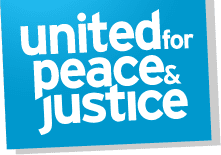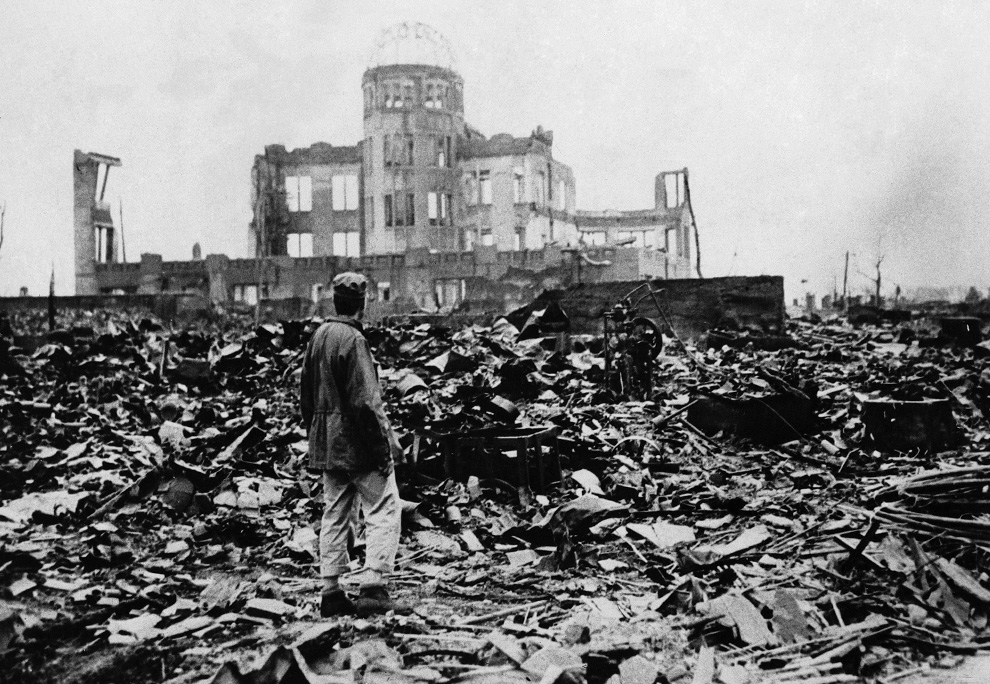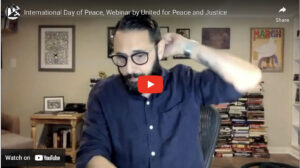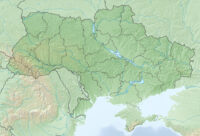Below, is the comment of the Western States Legal Foundation (WSLF) on the Memorandum of Agreement Between the United States Department of the Interior and the United States Department of Energy for the Manhattan Project National Historical Park. WSLF is a member group of United for Peace and Justice and it’s Executive Director, Jackie Cabasso also serves as Co-Convener of UFPJ.
Comment of the Western States Legal Foundation on the Memorandum of Agreement Between the United States Department of the Interior and the United States Department of Energy for the Manhattan Project National Historical Park
Submitted by Jacqueline Cabasso, Executive Director, and Andrew Lichterman, Senior Research Advisor, August 28, 2015
Western States Legal Foundation (WSLF) is a nonprofit organization based in Oakland, California, which since 1982 has worked for nuclear disarmament, peace and a sustainable environment. WSLF monitors and analyzes U.S. nuclear weapons programs and policies with a focus on the national nuclear weapons laboratories, Lawrence Livermore (LLNL) and Los Alamos. Since 1987 WSLF has participated in numerous NEPA and CEQA proceedings involving LLNL and the U.S. nuclear weapons complex.
The authors of this comment have visited the Bradbury Science Museum at Los Alamos, the LLNL Discovery Center, and the National Atomic Testing Museum in Las Vegas. In my capacity as WSLF Executive Director, I (Jacqueline Cabasso) also have served, since 2007, as an Executive Advisor to the Hiroshima Peace Culture Foundation. I have visited the Hiroshima Peace Memorial Museum and Peace Park and the Nagasaki Atomic Bomb Museum and Peace Park on numerous occasions, and have personally heard the testimonies of dozens of Japanese “hibakusha” – atomic bomb survivors.
The National Defense Authorization Act for Fiscal Year 2015 directs the United States Department of Energy (DOE) and the Department of the Interior (DOI), through the National Park Service, to work together to establish the a new national park “to improve public understanding of the Manhattan Project and the legacy of the Manhattan Project through interpretation of the historic resources associated with the Manhattan Project” (emphasis added)
The Draft Memorandum of Agreement Between the U.S. DOE and the U.S. DOI for the Manhattan Project National Historical Park states: “The purposes of this Agreement are to identify the facilities and areas under DOE’s administrative jurisdiction that will initially be included in the park and to establish a broad framework for the management and interpretation of those facilities and areas.” (emphasis added)
The FAQ posted on the National Park Service website is association with the Manhattan Project National Historic Park Memorandum of Agreement states: “The goal of the Manhattan Project National Park is not to celebrate the atomic bomb, but to educate the public about the history and legacy of the Manhattan Project that created it.” (emphasis added)
Historical events and artifacts have meaning only in context. That meaning changes constantly as the institutions, technologies, and practices they helped to constitute take further shape over years and decades. These meanings also are contested, the more so the more significant the events. The meaning of “the Manhattan Project and its legacy” is one of the most contested historical subjects of our era, the nuclear age.
The most terrible and immediate legacy of the Manhattan Project was the destruction of Hiroshima and Nagasaki by atomic bombs designed and assembled at Los Alamos, with materials and components from across the nascent nuclear weapons complex. The Park must not provide only the “view from the plane.” It must also convey, in excruciating detail, the view from beneath the mushroom cloud.
The U.S atomic bombings of Hiroshima and Nagasaki in August 1945 indiscriminately incinerated tens of thousands of children, women and men in an instant. Those bombs were tiny and crude nuclear weapons by today’s standards. By the end of 1945 more than 210,000 people – mainly civilians, were dead. Over 90% of the doctors and nurses in Hiroshima were killed or injured by the bomb. The surviving hibakusha, their children and grandchildren continue to suffer from physical, psychological and sociological effects of the bombings. Heath effects caused by genetic damage to future generations are still unknown.
To ensure that this story is accurately told, the DOE and DOI should engage in cooperative efforts with the Hiroshima Peace Culture Foundation, which oversees the Hiroshima Peace Memorial Museum, the Nagasaki Atomic Bomb Museum, the Mayors of Hiroshima and Nagasaki, and the International Committee of the Red Cross. The Manhattan Project National Historical Park should actively seek information, artifacts and exhibits from these agencies. Of paramount importance is the preservation and presentation of hibakusha testimonies.
In 1995, Hiroshima Mayor Takashi Hiraoka told the International Court of Justice: “History is written by the victors. Thus, the heinous massacre that was Hiroshima has been handed down to us as a perfectly justified act of war. As a result, for over 50 years we have never directly confronted the full implications of this terrifying act for the future of the human race.”
I (Jacqueline Cabasso) encountered the shortcomings of the “official” U.S. narrative of the atomic age during a visit to the National Atomic Testing Museum in September 2011.
The National Atomic Testing Museum is affiliated with the Smithsonian Institution. In a large museum with many exhibits I could find only four mentions of Hiroshima and Nagasaki. There was no exhibit showing the human tragedy caused by the atomic bombings. The short text on a panel describing “Little Boy and Fat Man” did not provide the number of casualties or any description of the health or environmental impacts of the atomic bombings. A panel next to this description showed a single photo of a man, apparently Japanese, well-dressed and looking uninjured, walking in a relatively empty part of Hiroshima, after the bombing. The impacts of nuclear weapons on human beings were presented by showing and describing the nuclear tests conducted using mannequins.
A more insidious feature of the “official” narrative is the unquestioned mantra that the atomic bombings of Hiroshima and Nagasaki ended World War II and saved American lives. A panel exhibited at the National Atomic Testing Museum, entitled Ending World War II, unequivocally states:
“On July 26, 1945, the Allied Forces [United States, Great Britain and Soviet Union] broadcast the Potsdam Declaration to Japan which demanded unconditional surrender. Japan rejected it. A belief that an allied invasion of the Japanese mainland would be very bloody grew (with estimates of up to one million casualties alone). Policy makers unanimously concluded the atomic bomb would end the war with the least bloodshed and should be used without warning against military targets. Accordingly two atomic bombs were detonated over industrial military targets in early August 1945. Japan surrendered shortly afterwards ending World War II, avoiding a massive Allied invasion and post-war division among the victors.”
This orthodoxy has increasingly been questioned by historians who have delved into the historical record, reading original documents in English, Russian and Japanese, and coming to very different conclusions regarding the “need” for the U.S. to drop atomic bombs on Hiroshima and Nagasaki and the factors that led Japan to surrender. Respected historians, such as Tsuyoshi Hasegawa, Barton Bernstein, Gar Alperovitz, and Ronald Takaki have explored the complex web of motivations and relationships among the U.S., Russia and Japan that brought World War II to an end and launched the Cold War. They have unflinchingly looked at the horrors of nuclear weapons and war with a critical view of all of the warring governments. These perspectives should be fully represented by the Manhattan Project National Historical Park.
The Manhattan Project ended in 1946. It is long past time to review the relationship of the Manhattan Project organization, sites, and scientists in constructing the rationale for the Hiroshima and Nagasaki bombings, the cover up of the impacts of the bombings, and the study of the impacts on survivors without their consent. Direct connections at a minimum should be documented and presented in the Park exhibits.
In some ways, the issues identified above are the easy part. But the Manhattan Project has left a much broader legacy, which also must be addressed. Following is a partial outline of issues with some illustrative examples.
- The legacy of the nuclear age itself. The U.S. decision to drop atomic bombs on two Japanese cities – a decision which could have been avoided – opened an age in which nuclear weapons were deployed and threatened to be used; in which there was and is a “balance of terror”. Once it was known by physicists that nuclear explosives could be created, that would always be a factor in post-World War II history. But the actual explosion of the bombs – on cities, on civilian populations – meant that history after there was knowledge would unfold in a particular, terrifying – and still terrifying – way.
- The legacy of the nuclear fuel chain; the impacts of uranium mining, nuclear weapons research, testing, and production, from Niger to Nevada, and theft of land for nuclear infrastructure, at each stage disproportionately affecting indigenous peoples in the United States and around the world. A few examples:
- The siting of the Manhattan Project in New Mexico and its subsequent transformation to the Los Alamos Lab profoundly disrupted and impacted the 16 surrounding Pueblo territories. (The Nuclear Borderlands: The Manhattan Project in Post-Cold War New Mexico, Joseph Masco, 2006, Princeton University Press)
- The Nevada Test Site was created by Executive Order of President Truman in 1951 on Western Shoshone land, still contested by the Western Shoshone Nation as a violation of the 1863 Treaty of Ruby Valley.
- Between 1946 and 1958 the U.S. conducted 67 nuclear detonations over the Marshall Islands, intentionally subjecting the indigenous population to the equivalent of 1.7 Hiroshima bombs daily for twelve years. The Marshallese people continue to suffer the health effects of radiation to this day.
- The legacy of the arms race and the threat of nuclear annihilation that never has gone away, and may be on the rise again.
- Some 15,700 nuclear weapons, most orders of magnitude more powerful than the Hiroshima and Nagasaki bombs, 94% held by the U.S. and Russia, continue to pose an intolerable threat to cities, and no disarmament negotiations are underway or planned.
- The National Defense Authorization Act for FY2016 passed by the Senate Armed Services Committee includes plans to design and build 12 new nuclear missile submarines, as many as 100 new nuclear-capable bombers, and up to 1,100 new nuclear-armed cruise missiles; to modernize approximately 400 intercontinental ballistic missiles and the various nuclear warheads in the U.S. arsenal; and requires the modernization and replacement of forward-deployed nuclear weapons, and dual capable fighter-bomber aircraft.
- According to a 2015 Congressional Budget Office report, over the next decade the U.S. plans to spend $348 billion on its nuclear forces, and a review of the 2014 Quadrennial Defense Review by the Congressionally-appointed National Defense Panel found that modernizing the nuclear arsenal could cost up to $1 trillion over the next three decades.
- The Los Alamos, New Mexico and Oak Ridge, Tennessee Laboratories, two of the three main sites encompassed in the Manhattan Project National Historical Park are actively engaged in programs to maintain and modernize U.S. nuclear weapons.
- Following the U.S. lead, all of the other nuclear-armed nations are engaged in programs to modernize their nuclear arsenals.
- Nuclear weapons have once again taken center stage on the borderlands of Europe in confrontations between the U.S., its NATO allies and Russia involving four nuclear-armed nations, and the confrontation in Europe is only one of several potential nuclear flashpoints, with new tensions and arms-racing from the Western Pacific to South Asia.
- The legacy of state secrecy that has eroded our fundamental principles of democracy. For example:
- In his August 6, 1945 press release, President Truman revealed to the American people for the first time: “We now have two great plants and many lesser works devoted to the production of atomic power. Employment during peak construction numbered 125,000 and over 65,000 individuals are even now engaged in operating the plants. Many have worked there for two and a half years. Few know what they have been producing. They see great quantities of material going in and they see nothing going out of those plants, for the physical size of the explosive charge is exceedingly small. We have spent two billion dollars on the greatest scientific gamble in history – and won.”
- The Manhattan Project’s secret budget and lack of legislative oversight were unprecedented. General Leslie Groves was the architect of the modern “national security” state, designing policies and practices to keep secrets from both foreign governments and the U.S. Congress and population. (From “Racing for the Bomb”, by Robert S. Norris, in The Manhattan Project, The Birth of the Atomic Bomb in the Words of Its Creators, Eyewitnesses, and Historians, 2007, the Atomic Heritage Foundation)
- The legacy of the “Atoms for Peace” program. For example:
- The spread of nuclear technologies, and hence the potential for nuclear weapons development, around the world.
- The negotiation and entry-into-force of the Nuclear Non-proliferation Treaty and the creation of an international system of “nuclear apartheid” (see below)
- Safe disposition of more than five decades’ accumulation of high-level radioactive waste that will remain deadly for many thousands of years to come presents a massive challenge for humanity that has yet to be addressed.
- The nuclear disasters at Three-Mile Island, and Chernobyl and still unfolding at Fukushima.
- The legacy of a nation and a world divided:
- A world divided between nuclear “haves” and “have-nots” with wars and threats of wars premised on preventing have-nots from acquiring nuclear weapons (eg. Iraq and Iran).
- A nation divided, with controversy and protest about atomic weapons (and atomic energy) from the beginning, even among the scientists who designed the Bomb. In the immediate aftermath of the U.S. atomic bombings, many of the world’s leading thinkers were appalled. Statements made by President Truman’s top military officials have been forgotten or suppressed. For example, Admiral William Leahy, President Truman’s Chief of Staff, wrote in his 1950 memoir I Was There that “the use of this barbarous weapon at Hiroshima and Nagasaki was of no material assistance in our war against Japan. The Japanese were already defeated and ready to surrender.… in being the first to use it, we…adopted an ethical standard common to the barbarians of the Dark Ages. I was not taught to make war in that fashion, and wars cannot be won by destroying women and children.”
- From the early “Ban the Bomb” marches to the “Women’s Strike for Peace” movement led by young mothers to ban nuclear testing, to the million people gathered in New York City’s Central Park in 1982 calling for the elimination of nuclear weapons, to ongoing annual protests at all of the major sites in the U.S. nuclear weapons complex, including those that will comprise the Manhattan Project National Historical Park, a vibrant, creative nonviolent movement for the abolition of nuclear weapons endures.
- The legacy of human experiments. Did the Manhattan Project set the tone for the internal institutional acceptability of the other human experiments that followed?
We have been here before. After a year of intensive planning, in 1995, the Smithsonian Institution cancelled an exhibit that was to have displayed and interpreted artifacts from the end of World War II in the Pacific. The exhibit was to have included a section on the Manhattan Project and would feature the fuselage of the Enola Gay, the airplane that dropped the atomic bomb on Hiroshima on August 6, 1945. The script for the exhibit had been approved by an advisory board of eminent historians. But the U.S, Air Force Association, whose members included both retired and active Air Force personnel, mounted a concerted public campaign, alleging that the script reflected an antinuclear and anti-military bias on the part of the curators, apologized to the Japanese for having dropped atomic bombs on Hiroshima and Nagasaki, and contained strong anti-American elements. This “controversy” was exacerbated by the media, and on January 30, 1995 Smithsonian Secretary Michael Heyman announced his decision to cancel the original exhibit. In its place the Smithsonian would display the Enola Gay, accompanied by a short video in which surviving members of the crew shared their thoughts about the mission they had flown fifty years ago. Heyman reportedly felt that the Smithsonian had made a fundamental error in trying to mount an exhibit that was simultaneously commemorative and analytic, concluding that these two agendas, while reasonable in their own right, were mutually incompatible. (The Debacle of the Enola Gay Exhibit: The Politicization of History, by
Stanley Goldberg, PhD, Medicine & Global Survival 1995; Vol. 2, No. 2)
The controversy resurfaced in 2003 when the Smithsonian’s National Air and Space Museum unveiled another Enola Gay exhibit. This time the Smithsonian raised no issues that might cast doubt on the morality or necessity of the atomic bombing. To the contrary, General John Dailey, the Air and Space Museum’s director, stated: “We are displaying it [the Enola Gay] in all its glory as a magnificent technological achievement…. Our primary focus is that it was the most advanced aircraft in the world at the time.” The exhibits label did note, that “On August 6, 1945, this Martin-built B-29-45-MO dropped the first atomic weapon used in combat on Hiroshima, Japan,” but said nothing else about nuclear weapons and their consequences, past or present. (Ugly History Hides in Plain Sight, by Kai Bird and Martin Sherwin, The Los Angeles Times, December 17, 2003.)In the run up to the opening of the 2003 exhibit, a statement was issued by the Committee for a National Discussion of Nuclear History and Current Policy, announcing that: “A committee of scholars, veterans, clergy, activists, students, and other interested individuals is now forming to challenge the Smithsonian’s plans to exhibit the Enola Gay solely as a ‘magnificent technological achievement.’ The planned exhibit is devoid not only of historical context and discussion of the ongoing controversy surrounding the bombings, but even of basic information regarding the number of casualties. We have formulated the following statement of principles, which we plan to circulate widely…” The Committee’s Statement of Principles was signed by dozens of prominent historians, academics, scientists, authors and activists. (http://historynewsnetwork.org/article/1773) The Smithsonian’s reply was nonresponsive, essentially restating its intention to present the Enola Gay in the narrow context of “the most sophisticated propeller-driven bomber of World War II.” (Committee for a National Discussion of Nuclear History and Current Policy archive, http://web.archive.org/web/20050304141134/http://www.enola-gay.org/#letter)
The DOE and DOI should learn the lessons of the two Enola Gay experiences at the Smithsonian Institution and apply them to the planning and development of the Manhattan Project National Historical Park. The DOE and DOI should not miss this opportunity to stimulate an honest public discussion of the atomic bombings of 1945 and of current U.S. nuclear policy. There is no reason why the Park’s exhibits cannot both preserve important historic sites and provide accurate historical information and analysis. Indeed they must. The 1994 script approved by an advisory board of eminent historians for the cancelled Smithsonian exhibit and the 2003 Statement of Principles issued by the Committee for a National Discussion of Nuclear History and Current Policy should be revisited and utilized as valuable resources in planning the new Park.




Hi, i have a free wordpress blog. I have added the widgets that come in the widget section. But how do i add widgets that are from third parties such as clustrmaps? If free wordpress blogs don’t allow that, which free blog service allows that ? .